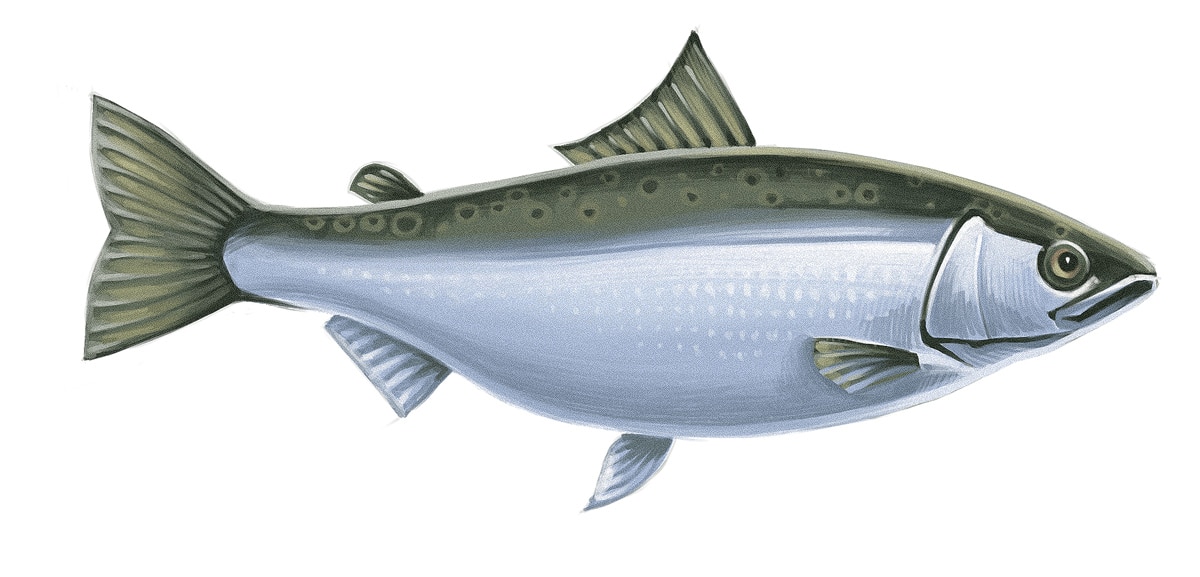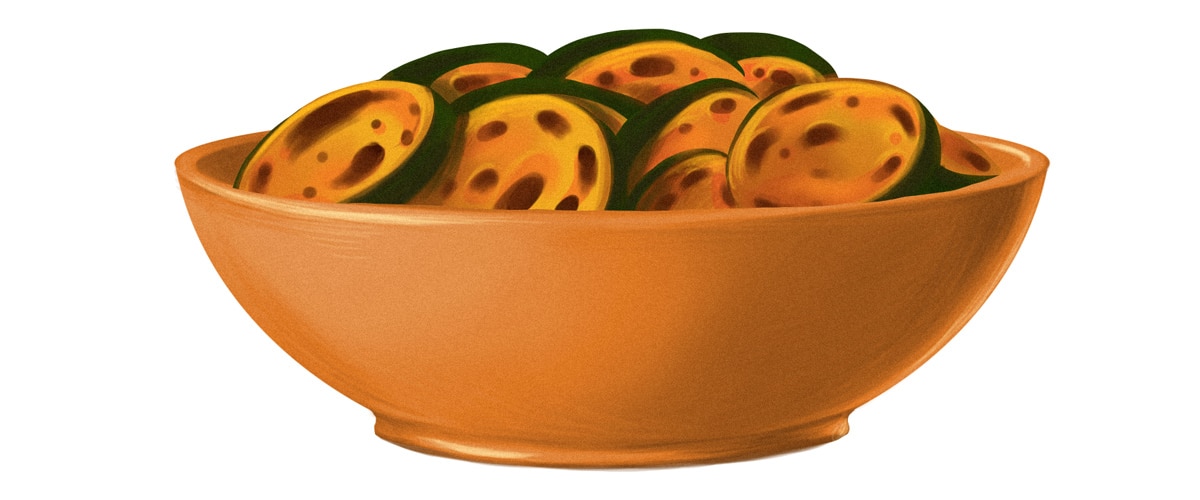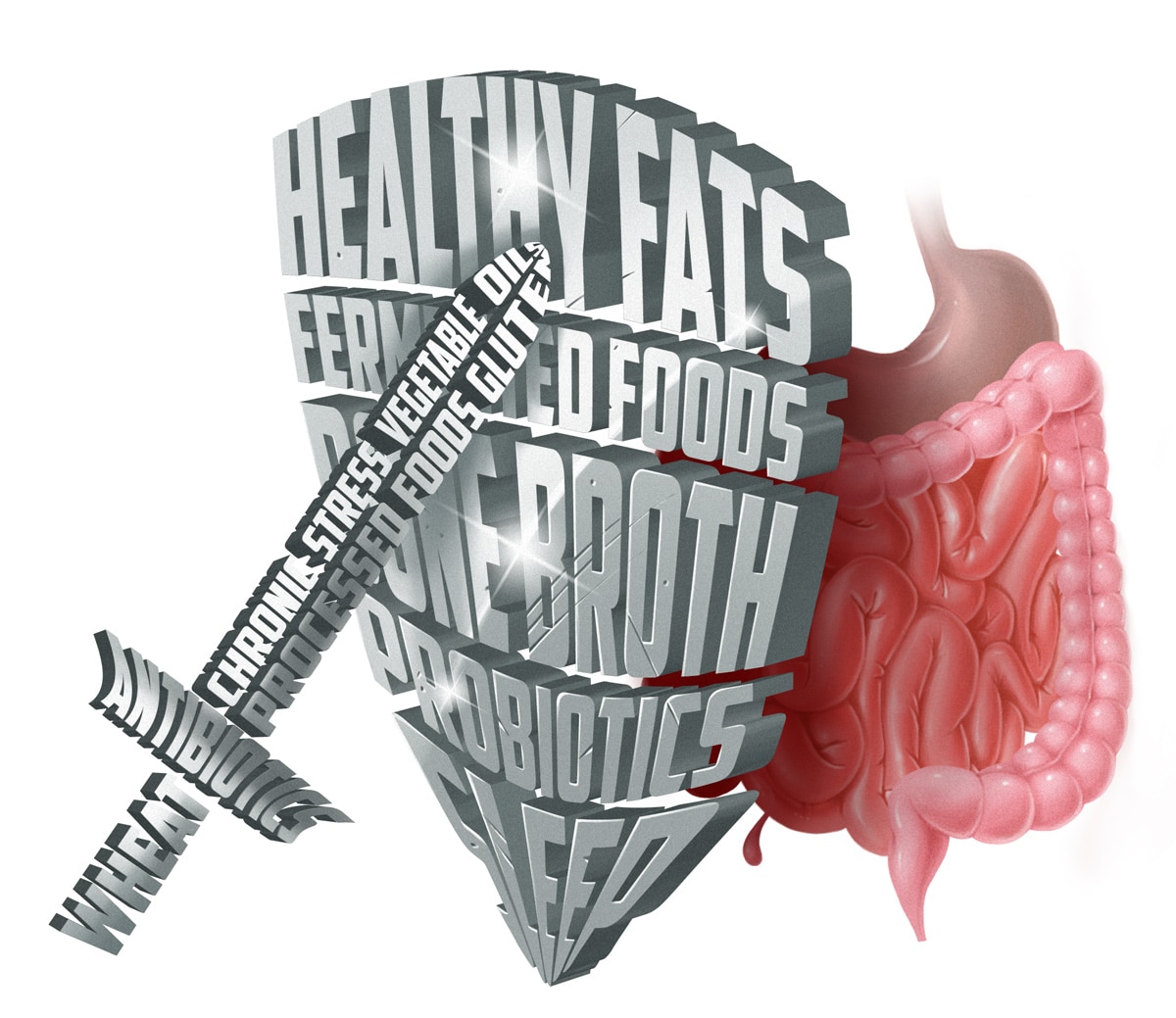We've also prepared a visual guide to histamine intolerance.
When you’re trying to heal your body from a lifetime’s worth of bad food, the worst symptoms are the vague ones. Headaches. Constipation. Fatigue. Maybe just a fuzzy sense of “not feeling great today.” This could be almost anything – how do you even know where to start?
Getting your Paleo basics in order (and giving the changes time to show, instead of trying the diet for a week and giving up) often cuts down on these nagging symptoms completely, but the magic doesn’t always happen quite so easily. For the people who still struggle with inexplicable symptoms, histamine intolerance is one problem that may (but may also not) finally give them an answer.
What Is Histamine Intolerance?
To answer that question, first you have to know what histamines are. In the most basic sense, histamines are chemicals produced during any allergic response. When an allergen triggers the immune system, mast cells (a type of white blood cells) release histamines as part of the inflammatory immune reaction. It’s this inflammation that gives you puffy, swollen eyes or a blistery skin rash. As well as being produced during the immune response, histamines can also be absorbed from histamine-containing foods, and produced by bacteria in the gut.
In healthy people, the production and ingestion of histamines is balanced out by an enzyme called diamine oxidase (DAO), which breaks down the histamines. Some processes create histamine; others destroy it, and overall the system balances out. But some people have a deficiency of DAO, so the histamines build up in their body, and cause a wide array of symptoms.
Many of these symptoms are familiar to allergy sufferers: rashes, hives, runny nose, swelling in the throat, and itching (with or without an accompanying rash). It’s basically the same old inflammatory allergic response, only without an allergen. But an overload of histamine can also cause an enormous constellation of problems, including migraines, digestive upset (constipation and/or diarrhea), nausea, and low blood pressure.
An important point to remember about this is that even though it sometimes feels like hayfever, histamine intolerance isn’t like a regular allergy where the allergic reaction is provoked by even a little bit of the substance. It’s the buildup that matters. Think of histamine like water pouring into a sink. Most people have an emergency drain (DAO) that prevents the sink from overflowing. But people with histamine intolerance don’t have that drain, so their sink eventually overflows.
Since the symptoms of histamine intolerance look like an allergy but aren’t, researchers tend to describe the problem as a “pseudoallergy:” all the symptoms of an allergic reaction, but without any allergen there to set them off. When your body is overwhelmed with too much histamine, or can’t clear histamine quickly enough, or both, you get an “allergic reaction” that isn’t actually an allergy, often manifesting as one or more of the incredibly vague symptoms that everyone hates trying to diagnose.
How can I tell if I’m Histamine Intolerant?
The symptoms listed for “histamine intolerance” are so incredibly broad that almost anyone could recognize at least one of them. But in fact, less than 1% of the population is actually histamine intolerant, so there’s a very good (99%, to be exact) chance that none of this even applies to you. Remember, these symptoms could be caused by an incredible variety of different problems: just because you have a headache after a glass of wine doesn’t mean you have a histamine intolerance! So how can you tell if histamine is really at the bottom of your problems?
Medically, you can have a DAO test done, to see if your DAO levels are normal. However, since other enzymes can also degrade histamine, this test isn’t a foolproof method of diagnosis. Another experimental but promising method of diagnosis is a skin prick test: it’s not perfect, but in one test study, 79% of histamine-intolerant subjects reacted to the skin prick, while only 19% of the non-intolerant subjects did. That’s better than random guessing, but still not particularly precise.
In women, the picture gets even more complicated. Like many other things, production of DAO fluctuates with the menstrual cycle: it’s higher during the luteal phase (starting roughly a week after your period ends, and lasting until the start of your next period) than during the follicular phase (the rest of the time). This means that histamine intolerance issues will likely be worse during the follicular phase (while you’re bleeding and then for a week afterwards), and show some improvement at other times, regardless of what you do or don’t eat. With this monthly fluctuation, it’s even harder to figure out what foods you might be reacting to.
DAO levels also increase during pregnancy, so many women notice a remission of their symptoms during pregnancy, only to see them reappear after the baby is born. In the whole slew of changes that occur during even a healthy pregnancy, it’s easy to miss out on the improvement of histamine intolerance symptoms, or to believe it has some other cause – after all, when you’re pregnant and everything else in your body is also going haywire, the last thing you’d suspect is a histamine problem.
Considering all the complications involved, the best method that doctors have for diagnosing histamine intolerance is an elimination diet. Four weeks without histamines, followed by a reintroduction challenge, is the most accurate way of determining whether or not a person is really reacting to the histamines in food. This is long enough to get an idea of a long-term trend, and for women, it’s also long enough to hit every phase in the menstrual cycle so you aren’t misled by temporary fluctuations.
Histamines and Food
If you want to try an elimination diet, the next thing to learn is what foods you’ll have to cut out. Remember from above that one of the ways to push your internal “sink” past the overflow point is by eating too many foods that contain a lot of histamine. Here’s the tricky part, though: for the most part, the biggest source of histamine in food isn’t the food itself. It’s bacteria on the food, which naturally produce histamine as part of their metabolic process. So anything aged or fermented will be big trouble for the histamine intolerant! Even leftovers can sometimes be “aged” enough to cause problems. Foods high in histamine include:
- (very high) Aged or fermented foods: kimchi, sauerkraut, yogurt or kefir, kombucha, aged cheese, alcohol of any kind, vinegar, and cured meat.
- (very high) Fish and seafood, especially canned or smoked fish.
- (medium) spinach, eggplant, mushrooms, tomatoes, canned vegetables, dried fruit, avocados, strawberries, papaya, pineapple, and leftovers.

If you want to get specific with the numbers, this chart shows a partial list of histamine-containing foods, together with the amounts found in them: as you can see, the results vary from study to study, sometimes drastically. So there’s no foolproof way to list foods from high to low histamine content, and your reaction to specific foods might vary widely: eating the fish in one restaurant might be fine, while the fish from the restaurant next door leaves you breaking out in hives.
Then there’s a second category of foods that don’t contain histamine themselves, but can cause your body to release more of it. These foods include:
- Fruits and vegetables: citrus fruit, papaya, strawberries, pineapple, tomatoes, spinach
- Meat: Fish, shellfish, and pork
- Other foods: Chocolate, nuts, and raw egg white
Individual sensitivities to these foods vary a lot. Most people only have trouble with the very high-histamine foods and don’t need to eliminate anything else from their diet. In this study, for example, a boy suffering from atopic dermatitis improved just by eliminating the foods highest in histamine and then making sure not to rely on moderate-histamine foods as his everyday staples.
Since there’s no reason to eliminate foods unless you have to, a good starting point for an elimination diet is to cut out the very high histamine foods, and then experiment with different tweaks once you can see whether it’s helping at all or not.
Eliminating Histamines from a Paleo Diet
If you’re interested in trying an elimination diet for histamines, the list of forbidden foods can seem incredibly daunting. After all, many of these foods are Paleo staples. Surprisingly enough, this is one problem where grains are largely innocent: wheat has many evils, but histamines are not among them!
It might seem like a low-histamine Paleo diet would be totally unworkable, given that so many sources of protein and fat are off the table, but like a low-FODMAPs diet, the key is planning. The Whole30 program has a special low-histamine shopping list to help you work a very strict Paleo diet around low-histamine guidelines, and you’ll find that once you get used to low-histamine cooking, it starts to get easier. For some recipe ideas, check out:

It may also help to make sure your meat is as absolutely fresh as possible, or was frozen as soon as possible after slaughter. The more the meat “ages,” the more histamine it accumulates. The best solution is to find a farmer you can get to know, and ask him or her about how the meat gets from the animal to you: how long between slaughter and freezing? What is the meat processing like?
If it’s really not possible for you to stay entirely Paleo while you’re trying a low-histamine diet, also take a look at the article on Paleo for vegetarians, which gives you some tips on preparing beans and other vegetarian staples to make them much less harmful. That still doesn’t make them healthy (just less bad), but it’s a lot better than giving up and going back to Wonderbread.
In the long term, there’s also hope that you won’t have to carry on this level of restriction forever. For example, as your gut heals, your ability to metabolize histamine increases, and you can include more of it in your diet without suffering symptoms. And many people don’t react at all to certain histamine-containing foods; they discover through an elimination diet that they only really need to cut out one or two big offenders to see results.
Other Sources of Histamine: Medications and Gut Flora
Food isn’t the only way of filling up your “histamine sink.” Some prescription drugs can also either release histamine or inhibit DAO. They include several different classes of drugs; the full list is here.
The biggest nonfood source of histamines in most people’s bodies, though, is their gut flora. Some kinds of bacteria produce histamines, while others degrade them. Too many histamine-producing bacteria can fill up your “sink” faster than DAO can empty it. If you think about it, this makes perfect sense: it’s the same reason why fermented foods are off the table, only the reaction is happening internally instead of externally.
The importance of gut flora in creating and destroying histamine can give rise to a sudden onset of histamine intolerance later in life, if you take antibiotics or make a drastic change to your diet. When the gut flora start growing back after this kind of trauma, the environment is ripe for bacterial overgrowth problems, and a predominance of histamine-producing bacteria might be just one of those issues. And in a cruel coincidence, the probiotic fermented foods that you eat to heal your gut are all high in histamine, so they only make the problem worse.
And the gut problems don’t stop there. DAO, the “emergency drain” in the histamine sink, is mainly produced by the mucous lining the intestinal wall. If the lining of the gut is irritated (by inflammatory foods like grains and legumes), DAO production decreases, and the symptoms of histamine overload only get worse.
To sum it all up, good gut health is just as important for histamine tolerance as it is for everything else. Unhealthy gut flora might even be able to create histamine intolerance problems in a person who would otherwise be completely healthy.
Living with Histamine Intolerance: Gut Healing

Since the gut flora are so important for histamine production and breakdown, one of the most important long-term steps to living with histamine intolerance is healing any gut dysfunction. By eliminating one source of excess histamine (dysregulated gut flora) and repairing your source of DAO (the gut lining), you can dramatically increase your body’s ability to handle histamines in food. This is like carving a new emergency drain into your “histamine sink:” it gives you a little more leeway to add water without overflowing.
Gut healing on a low-histamine diet seems like a paradox, because the fermented foods that you need to heal are the same foods that are causing the problem! It is possible to restore normal gut flora without sauerkraut, though:
- This is the perfect situation for a well-chosen probiotic supplement. In this study, a supplement with two strains of bifidobacterium actually suppressed histamine release. In another study, Lactobacillus rhamnosus helped suppress histamine receptors.
- If you’re not interested in micromanaging your probiotic strains, don’t worry: you have another option that might be even better. This new treatment is confusing, because it sounds almost the same: prebiotics are just one letter away from probiotics. Instead of a supplemental dose of gut flora in pill form, prebiotics deliver a tasty banquet of fiber to the flora that are already in your intestines. They’re basically a kind of carbohydrate indigestible to humans, but absolutely delicious to the bacteria.
Prebiotics require a little bit of caution: in people who have too few gut bacteria, they’re excellent, but in people who have too many, they’re just more fuel on the fire. That’s why some people react so poorly to FODMAPs-rich foods: the FODMAPs carbohydrates are all prebiotics, so in people with a pre-existing gut flora overgrowth problem, they’re poorly tolerated. The safest and cheapest way to find out whether prebiotics can help you is to try them. If you feel bloated, gassy, and constipated afterwards, they’re not for you. On the other hand, if you notice an improvement, keep going!
Living with Histamine Intolerance: Other Therapies
In terms of supplementation, there are also several options for you to try, although the results are very mixed. Nigella sativa (black cumin) is one spice that has shown some promise as a natural anti-histamine for treating seasonal allergies: in a study, for example, it was just as effective as a prescription drug at reducing symptoms. Quercetin is another common supplement – it can reduce the release of histamines from mast cells.
Some people find that DAO supplements (special enzymes that help your body break down histamines) brings them miraculous relief; others notice no change or even worse symptoms from taking them. The big downside to these supplements is the price. If you have only occasional problems and just need a supplement once in a while, they might be a good backup strategy, but otherwise they’re prohibitively expensive for long-term use.
Another point to consider is nutrition. Vitamin B6, copper, and Vitamin C are DAO cofactors, so make sure you’re getting enough. Good low-histamine sources of these nutrients include:
- Vitamin B6: chicken, turkey, and potatoes
- Copper: asparagus and liver
- Vitamin C: almost all fruits and vegetables
Since over-supplementation of Vitamin C is useless (it just goes straight into the toilet) and overdoses of Vitamin B6 and copper can actually cause serious problems, it’s better to get these nutrients from food rather than start megadosing on vitamin pills.
Conclusion
As always, the internet is no substitute for an actual medical professional to help you. It can be an exercise in frustration to talk to your doctor about these symptoms, because histamine intolerance is very rare, poorly understood, and difficult to treat. There aren’t even foolproof diagnosis criteria: many researchers simply use questionnaires or reports of symptoms. Here’s a good study (free full-text) that you could print out and bring with you to help convince a doctor that you aren’t making up your problem. If you go into the office armed with proof, you’re much more likely to get a helpful response.
The most important thing, though, is to keep it all in perspective. Very few people are actually histamine intolerant. Statistically, you’re unlikely to be one of them. If you don’t feel ill after eating fermented foods and have no reason to suspect a histamine intolerance, there’s absolutely no reason to be anxious about perfectly healthy foods like fish and spinach. Healthy people can metabolize the histamine found in foods without a problem, so go ahead and eat your sauerkraut: it’s good for you! It’s always frustrating to deal with nagging symptoms that won’t go away, but there’s also no point in constantly eliminating more and more foods when you know in your heart that it isn’t helping. Try it out, see if it works for you - and if it doesn't, move on.





Leave a Reply